Classic Italy tours
Venice, Como and the lakes | Cremona, Mantova, the Alps, Ortisei, Val Gardena | Pisa, Assisi, Siena, Florence, S. Gimignano | The Amalfi Coast and Isle of Capri | The Magical South and Sicily
The Magical South and Sicily
Tour suggested of 9 days and 8 nights starting from Rome, with the visit of Naples-Pompei, Paestum, Matera, Alberobello, Castel del Monte, Palermo, Agrigento and Siracusa, the service is driver/guided and is individually personalized.
| 1st Day: Pompei and Paestum. We will start the tour from your Hotel, drive along the motorway through the regions of Lazio and Campania. Pompei: Inhabited since ancient times, the first traces of a fully established human settlement date back to the seventh century B.C, when Pompei was used as a strategic commercial center by the Etruscan and Greek populations who chose the location for its opening on to the sea. The world wide fame of Pompei is, without the shadow of a doubt, linked to the eruption of the Vesuvius of August 29th of 79 A.D. which completely buried the city and the neighbouring towns of Herculaneum and Stabia. The hidden town was discovered by pure chance in 1594 by the Architect Domencio Fontana during the making of a trench. Excavations were initiated in 1748 by Carlo di Borbone whilst in the more recent past digs were supervised by Amedeo Maiuri in 1924 and by De Franciscis for those of 1961 which resulted in the uncovering of three fifths of the entire city. To visit whilst in Pompei, in addition to the archaeological site: the Amphitheatre, the House of Vettii, the House of Faun, the House of the Silver Wedding, the House of Menander, the Sanctuary of Pompei, the Basilica, the Museum of the Papal Sanctuary of Pompei, the Vesuvian Museum G.B. Alfano, the Temple of Apollo and the Villa of the Mysteries. Overnight stay in Paestum. |
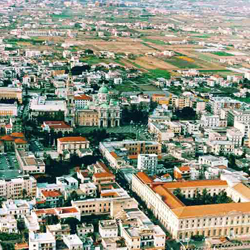 |
| 2nd Day: Peastum. Peastum: A short distance away from Salerno, in a position dominating the Piana dei Templi, rises Paestum. The city, rich in history and archaeological sites, offers the tourist an impressive display of natural scenery with its spectacular sea, and coastal landscapes and its green countryside, scattered with walking routes. To visit: the Hera Sanctuary, the Basilica, the Temple of Cerere or Athena, the Amphitheatre, the Forum, the Diver's Tomb, the ancient walls of Paestum which, in approximately five kilometers of wall, form a pentagon around the city. Built in more recent times one finds the Madonna del Granato, destination of pilgrimages, and the Church of the Confraternity of the Rosario. As far as traditional products of the area are concerned, particularly worthy of note are the Mozzarella di Bufala, the Paestum Artichoke, the Cilento Extra Virgin Olive Oil, and the marvelous local Figs. |
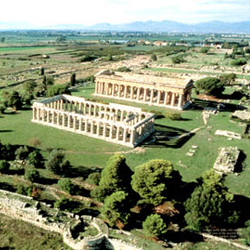 |
| 3nd Day: Alberobello and Andria (Castel del Monte). After breakfast we will continue the tour driving through the regions of Campania and Puglia to Alberobello. Tourists come to Alberobello from all over the world to see its unique urban landscape. The town has become famous internationally because of its "Trulli", cone shaped houses constructed in stone blocks known as chiancole. Alberobello is sited on two hills, divided by a river. The Western hill is the oldest part of the town and here the largest number of Trulli can be found. The old town is divided into two districts, Aia piccola and Monti, which are of national importance and have been granted special status by U.N.E.S.C.O. Profuse greenery, olive and almond trees cover the hillsides. Craft industry is particularly important, with all types of traditional products being made. Not to be missed: the itinerant market, held every Thursday morning and the Saturday afternoon market, held in the Coreggia district. On Wednesday and Saturday evenings the town's butchers organise the Fornello pronto, a delicious barbecue. The celebrations for the Patron Saints Medici Cosma and Damiano are well worth attending. Overnight stay in Alberobello. |
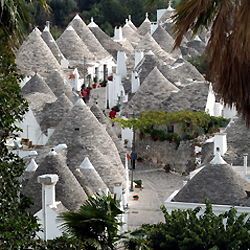 |
| Andria (Castel del Monte) The second most populated city in the province of Bari, Andria can be found at the foot of the Murgia, a fascinating land rich in history and culture. Andria was already inhabited in prehistoric times. Many traces of its past are preserved and can be seen in the architecture, museums and churches of the town. To visit: Andria Cathedral which guards the mortal remains of Jolanda of Brienne and Isabella of England, wife of Federico II. Also to see are: the Church of St Agostino, the Church of St Francesco, the Church of St Domenico, the Church of St Maria di Porta Santa, Palazzo Ducale, the Clock Tower, the Diocesan Museum, and Porta St Andrea, otherwise known as Arco di Frederico II. The Basilica of St Maria dei Miracoli, the Crypt of Santa Croce, built in the clay soil, the famous Monument Disfida di Barletta and Svevo Castle del Monte, erected on the hill of the Murge, are all within easy reach of Andria. Overnight stay in Matera. |
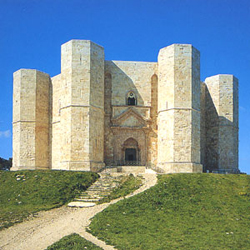 |
| 4rd Day: Matera. Matera is located in the region of Basilicata, and is one of the most ancient towns in the world becouse of the continual presence of mankind from the Paleolithic age up to present times. To visit is the "Civita" the most ancient part of the town of Matera and archaeological research as proved that the "Civita" was one of the prehistoric settlements in the area surrounding Matera. The city is the most important example of a Troglodyte settlement in the Mediterranean, perfectly adapted to the land and its eco-system. The “SASSI” alleys caves and churches create a very particular atmosphere of years gone by, that will leave you speechless. The UNESCO has recognised the “SASSI” a world wide heritage site in 1993 Overnight Stay in Matera. |
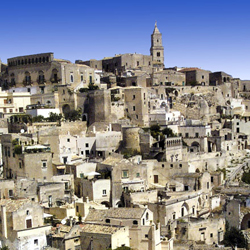 |
| 5 th Day: Drive to Reggio Calabria and embark to Siclily. |
| 6th Day: Palermo. Sicily, the region is a book of history and art, a compendium of the greatest civilisations and cultures of all time. A sunny island whose landscape is rich in contrasts, with a splendid coastline and a refined, delicious and varied cuisine of traditional flavours and exquisite aromas. We will visit Palermo the capital of Sicily, derives its name from the Greek “ panormus”, meaning “all Port”. Through history the city has been conquered by the Phoenicians, the Greeks, the Romans and the Arabs, the civilizations of which have all left their mark, and contributed to its great architectural and cultural importance. Among the many monuments, there are numerous buildings of great significance such as Palermo Cathedral, the Norman Church of St Giovanni degli Eremiti, the Church of St Maria dell'Ammiraglio, also known as Martorana, the Church of the Magione, Palazzo Abatellis, Theatre Politeama and the Sicilian Regional Gallery. A visit to the Massimo Theatre, one of the largest and most prestigious theatres in Europe, should be on every tourist's itinerary. Many artists, poets and writers have cited Palermo in their works, amongst these are Petrarca, Dante, D'Annunzio, and Wolfgang Goethe, who proclaimed Palermo to be "a land of indescribable beauty". Overnight stay in Palermo. |
 |
| 7th Day: Agrigento. From Palermo we will drive to the Greek city of Agrigento, it was described by the Greek poet, Pindaro as the most beautiful city inhabited by the mortals. It is the birth place of the Noble Prize winner, Luigi Pirandello. The economy of Agrigento is reliant upon horticulture and agriculture. The extensive cultivation of almonds led to the city being known as "The Almond in Flower". There are many olive groves and citrus orchards. Cereals are also grown. Among the many monuments of note are: Agrigento Cathedral, the Church of St Nicola, the Archeological Museum, the Monastery of St Spirito, the Church of Purgatorio, the Church of St Maria dei Greci, the Art Museum, the house where Luigi Pirandello was born, known as "il Caos". Not to be missed the Valle dei Templi, just South of Agrigento, a group of Temples erected in the V century BC to celebrate the town's prosperity. Overnight stay in Agrigento. |
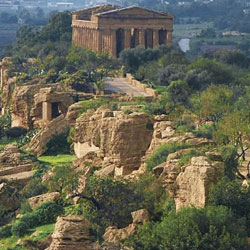 |
| 8th Day: Siracusa. Founded by the Corinthians, the name Siracusa derives from the nearby marshland, "Sykara". Over the centuries, Siracusa has been conquered by the Romans, the Byzantines, the Goti, the Arabs, the Normany, the Genovesi, the Svevi and the Aragons. This vibrant history has left it with a wealth of monuments, the most important of which can be found in the Archeological park of the Neapolis. Here one finds the Greek Theatre, the Roman Amphitheatre, the Latomia del Paradiso, the Grotta dei Cordari, the Ara di Lerone, Porta Urbica, Apollo's Temple, the Cathedral and Athena's Temple, Zeus's Temple, the Gymnasium, the Catacombs, the Paolo Orsi Museum and Eurialo Castle. Whilst at Siracusa visitors should not miss the opportunity to see the Regional Gallery of Palazzo Bellomo, the Museum of the Papiro and the Cinema Museum. The principal economic activities of Siracusa, despite the increase in modern industrial activity, are still those based on agriculture, cattle farming and fishing. Among the gastronomic delights the tuna fish, purpetti di tonno da Zà Cicca really must be tasted. Overnight stay in Siracusa and in the morning of the 9th drive back to Rome. |
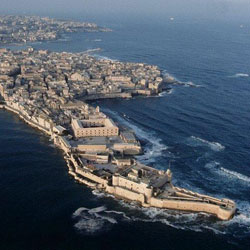 |